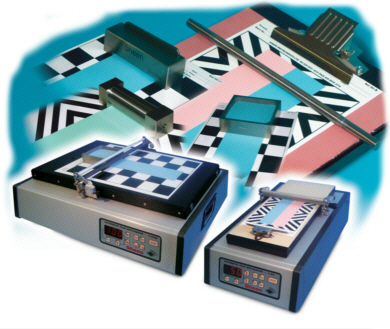|
|
|

|

|
|
Introduction
|
|

|

|

|

|
|
It is recommended that all units be periodically checked for accuracy by using a feeler gauge, as normal use and cleaning will, after time, render any applicator inaccurate. Units should be disposed of and replaced when readings are no longer accurate. Should an applicator be dropped or the blade become nicked, it is also advisable to replace it.
Numerous types of applicators have evolved over the years, but most fit into two types: adjustable and fixed clearance / gap. Applicators mayaiso have single or multiple gaps. Most applicators have shoulders or side arms that hold the pool of sampie in front of the gap while the device is drawn down. The gap on most applicators has a flat shearing edge which yields a wet film to gap ratio of approximately 1 to 2, although this ratio varies with several factors, such as application technique and coating composition. Fixed models are easier to clean and maintain; adjustable models should be disassembled and cleaned after every use.
The quality of the draw down is governed by three main factors:
- Viscosity of the film
- Speed and uniformity of the application
- Flatness of the surface
A variety of viscometers can be used to control viscosity.
Olbrich know how also offers an automatic film applicator wh ich controls the rate of application and planeness of the applicator, assuring a uniform film thickness.The wet film to gap ratio is a result not only of the shape of the shearing edge, but the fluid's viscosity, the speed of the applicator and other factors. The exact wet or dry film thickness can be determined only by measuring the wet or dry film with a film thickness gauge.
|
|
|
|
For very thin films, the use of wire wound rods is recommended. These applicators are drawn across the surface in the same manner as the blade type, but the coating flows through the grooves between the wires and produces a thin, uniform drawdown. These instruments are particularly useful to simulate paper or foils.
|
|
|

|

|

|

|
|

|
|
|
|
- Automatic Film Applicator
The Automatie Film Applieators are made with high precision maehined eomponents, sturdy maintrame and heavyduty power chain assembly, to ensure long term reliable operation. Consistent drawdown eonditions sueh as speed, tlatness, eombined with applieator gap and geometry are essential to obtain perteetly reproducible sam pies, thus eliminating human error and uncertainty
. Link Link
|
|
|
|

|
|
.Wet Film Preparation
Reliable and accurate testing of coatings and films, such as those in the paint and coatings industry, requires rigid control of their actual (not assumed) wet and dry film thickness. Hiding power, opaqueness, scrub resistance, sag resistance, and many other quality tests require a uniform, repeatable film for routine QC and R&D testing. Many ASTM, ISO, Federal, and other specifications specify films of predetermined and uniform thickness.
The most common method of spreading a sampie is with a film applicator. Film applicators can lay down wet films of almost any desired thickness from a few !-Im up to> 1000 !-Im.
Dry Film Thickness
A typical applicator consists of a metal bar containing a gap of known depth or clearance on one or more faces. It is placed near one end of a flat panel, such as a drawdown chart. A sufficient volume of sam pie is placed in front of the applicator. The applicator is then "drawn down" the chart, either mechanically or manually, leaving a uniform film behind it. Mechanical methods give better repeatability and accuracy, as operator deviations are minimized.
Stainless steel and anodized aluminum are the preferred materials of construction, due to their resistance to corrosion.
|
|
|

|

|
|
Spreading Rate Charts
Large size charts (1000 cm2), reterred to as spreading rate
charts, were designed tor visual hiding power methods. The paint is spread unitormly on a detined test area and the spreading rate calculated trom the weight and density ot the applied coating.
ASTM D 344 uses Form 8H and lOH. Forms 12H and 13H provide areas tor wide aperture photometrie measurements
|
|

|
|
|
|
REF. No.
|
REF. No.
|
REF. No.
|
REF. No.
|
|
2801/2803
|
2822
|
2823
|
2824
|
|
|
|
|

|

|
|
Ordering Information Technical Informationen
|
|

|
|
|
|
REF. No.
|
Description
|
Maße
|
Qty
|
|
|
|
Box
|
|
2824
|
Spreading Rate 10 H
|
286 x 438 mm (11,25 x 17,25 in)
|
125
|
|
2823
|
Spreading Rate 8 H
|
286 x 438 mm (11,25 x 17,25 in)
|
125
|
|
2822
|
Spreading Rate 12 H
|
286 x 438 mm (11,25 x 17,25 in)
|
125
|
|
|
|





